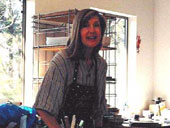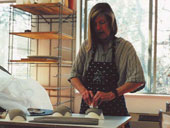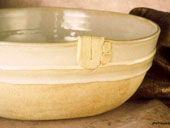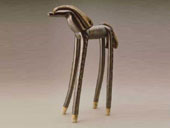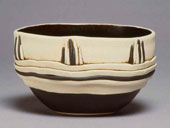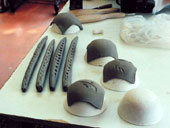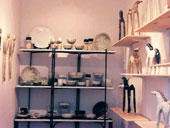Learning Library Segments
Rebecca Roberts
Primary Use of Medium: Sculpting ClayInterviewer: Donna Wetegrove
Interview Location This interview takes place with Rebecca Roberts in her studio in the company of her cat, Rutile (the name of a chemical used in her glazes).
Interview Date: 1.21.99
Writer: Monique Duncum
Inspiration
Art Form/Product
Green Aspects
Marketing Values
Special Offering
Additional Comments
Artist Profile
Inspiration
"Earth and nature are the magic of the unconscious."What Type Of Artist Do You See Yourself As?
Rebecca is quick to answer, "Potter", an answer she says she is comfortable with because the process is what is important to her. She loves working with the earth; "it is humble work".
How Did You Get Here?
As a child, Rebecca was intrigued with mudpies. Using her mother's Haviland china as molds for her mudpie creations, she developed a process that is still very much in place today. Molds and forms continue to shape her clay pieces. She began her venture by entering compositions of earthy things made from bark, moss, etc. in the state fair, where she won numerous ribbons. The fascination and her use of earthy media continues to be a source of great joy.
Rebecca was never allowed to take any art classes when she was young - as they were considered "frivolous". Consequently, in college, she originally pursued a legal career, and later changed her major to speech therapy. Eventually she made her own way back to the arts by experimenting with paper mache because she was "hungry to be creative". At that point, she did not know what a "potter" was. A friend finally took her into the art department "pot shop". That exposure became life altering when she realized this was It! Rebecca went back to school and studied art. Her professors became a great influence on her.
Branching out on her own, it was important
In the beginning, it was important to balance between teaching others and her own studio work to support herself. To this day, she continues teaching, but finds that potting is not so much about technique. She really wants students to integrate their own interpretations into the clay. Rebecca finds that when teaching students with some experience, they pick up on nuances, tiny details like the angle of the needle tool in refining an edge. That, she finds, is very exciting; reminding her of things she takes for granted in her own process.
Her love affair with clay has been going on for almost thirty years now. For Rebecca, "clay is the greatest teacher".
Where Does Your Inspiration Come From?
Functional sculpture and functional work is a huge part of Rebecca's life. Her communication is best through the clay. The ritual of eating, sharing, and nourishment is a large part of her work, focusing on, as she notes, one of the few remaining rituals that remain in our lives today. It brings her much personal pleasure to have her work be a part of the kinds of rituals that touch people's lives. Food is a big priority in our lives, "so why not make the shapes for and how we like to eat". This is the inspiration for each hand-crafted piece. Through this hand-building, Rebecca allows herself to develop a relationship with each piece that is different than throwing clay on a wheel. She enjoys taking that extra time.
"Sculptural things come from a deeper place." Rebecca began to see the how inspirational the horses she had as a youth were when her bowls became boxes with legs. These boxes evolved into her sculptural horses when she took a sabbatical from her functional dinnerware.
Feedback from her customers is always very astute, allowing her to see those aspects she might normally miss because she is so close to it. Her pieces are always about her inner life.
Art Form/Product
"Clay is so basic"How Would You Describe Your Work?
It was Rebecca's love for sculptural work in the beginning that called out to her; and yet, she needed to make a living. She began with bowls; all different shapes of bowls. Many were formed over grapefruits and each consequently was different because every grapefruit is different. It was a business decision to standardize types and formed shapes so they could stack on a shelf, for instance, and fit in a cabinet. Customer feedback came, and with evolution, she developed her line of dinnerware. It had a basic design - a quiet design, and yet one with a lot going on with it.
Why Do You Like The Medium?
"Clay is so basic. I chose the medium because of it's seduction - it just happens to be functional and useful."
Rebecca's sculptural work uses experimental textures and glazes which are different than those that we can eat on in her functional pieces. "Anything goes and you can dive into surface decoration in a completely different way. To Rebecca, it is a very exciting process. "All art is functional."
Does The Material Dictate The Design Or Does Your Design Idea Dictate How The Material Is Used?
The seams, marks made with her fingers, marks of the clay, impressions of the canvas she uses and marks from the tools are left to show the process because it is what she has a love affair with. The bowls could now be the same size and yet each one different because it is built in steps - a building block process. Then Rebecca started to name her bowls: the grapefruit bowl, the chopstick bowl (you can hold it in one hand!) and the all purpose soup and salad bowl. Each received her embellishing ideas that continued to make them unique. She did this type of work for many years.
Rebecca's sculptural thinking is occurring all of the time and she lets it surface because she chooses it. She acknowledges that the dichotomy in her work is not yet balanced. She feels a shift in her work may be eminent still. Staying open to and paying attention to visuals and words is important. "Everything that I have tried has not always come full circle it is the going there that is important." Rebecca knows that it is also important for her to not think it through too much. That is why she does not sketch fully before she starts to work with the clay. She would rather "sketch in the clay." She points out, however, that everyone works differently. "Find out what works for you and be true to yourself."
What Brings Your Medium To Life
"The clay brings itself to life. The key is staying out of its way and knowing when to stop." "Once again, clay is so basic." Rebecca's pieces look like fabric in some cases. It has folds and tucks and overlaps. She prefers the organic look of clay rather than rigid, harsh finished pieces.
What Tools Are Required In Your Process?
Rebecca answers, "not the wheel!" For her, creations are begun and transformed solely by hand building. The use of fingers, a board and a good slab roller (one of her capital investments) are essential elements. "The slab roller allows you to produce a consistent sheet of clay with less wear and tear on the body." Other useful tools Rebecca says she cannot live without include a tooth brush, a rolling pin, cloth, forks, knives, and material scraps. Rebecca encourages looking around for alternate sources of materials to utilize and embellish with. Additional items needed to complete clay pieces include string (for cutting), needle tools, plastic (to slow the drying process she uses dry cleaner bags), and of course a kiln to fire the final product. She adds that tools are really dependent on the process chosen. However, Rebecca does recommend prioritizing the purchase of a kiln in your process.
Please Summarize Your Entire Process.
Clay is purchased from a quality supplier along with other raw materials. Rebecca proceeds to roll the clay into a slab, cut out the pieces, and begin the building process. The moisture level must be kept consistent because the clay shrinks as it dries. Once built, the piece is allowed to dry and is then fired for the first time. Stain is applied to areas that will not have glaze applied, other areas are glazed, and then the piece is fired for the final time.
In the step-by-step process, while the piece of clay is flat or on the hump mold, texture is added. A hump mold is that which shapes and supports clay pieces as they dry. The clay shrinks and stiffens as it dries. "You have to pay attention to the shrinking aspect as this is when the clay will split if you let it go too long and you won't be able to get it off the hump mold." For an opposite effect, a press mold texturizes the inside of a piece something you lay the slab into. For Rebecca, the insides of her functional pieces are usually fairly smooth since one will be eating out of it.
Rebecca makes her own hump molds. She goes to garage sales and looks for shapes she finds interesting. She then pours plaster into the shape and lets it dry. She will make several castings of a new shape to allow for the availability of multiple forms to speed the productivity of making several pieces at one time. "It is logically a better use of the clay slab. You cut shapes out of clay like a puzzle to maximize all the material or slab."
Rebecca's favorite part of the process is the time while the clay is wet. She refers to this period as the "babysitting" time - the pinching, rolling, and adding process. Rebecca states "it is absolutely the working with the wet clay that is the gift of clay to me. I love it!." She also finds the staining & waxing process to be "like a meditation it becomes instinctive so that my mind can be somewhere else." However, when it comes to glazing, she says she has to pay attention.
When people order a dinnerware set, part of Rebecca's process includes interviewing for the individual's tastes and needs. Questions such as: "How do you eat? What do you like? What do you do in your process?" are addressed. Many times, people are surprised by this. However, this provides a chance for them to choose what works for them and makes allowances for the opportunity to be non-traditional. Rebecca goes on to say, "the clay continues to teach me about non-traditional ways to engage with food and to support someone's lifestyle."
The true process entails so much more. Rebecca comments that "marketing is a whole different story." Marketing products requires picture taking, having slides produced by a professional and the completion of numerous applications to shows. She points out that one must learn to accept rejection no matter how long you have been in the business. You must continue to support yourself and make your life's business out of it.
Do You Recommend What You Do As A Career Choice? Why?
"Definitely!!" If someone has a passion for clay or thinks that they do, Rebecca recommends that they give it a try. Start out by working for someone in a local studio. The experience will allow you to see every possible side of the medium. "Don't just wish you had tried put yourself in the environment for the training experience. You can always go back to a traditional job!" Rebecca has chosen clay, at times, even to the detriment of her financial success. "Being an artist is not always easy." She goes on to say, "I would not trade it for the world clay is my lifeline."
What Tips Might You Have For Someone New To The Medium? How Best To Develop Their Interest?
"Develop your skills. Anyone can set up as a hand builder in a closet to get started." It would be quite helpful, she adds, to balance that initial set-up with inexpensive classes. Through classes you will have access to a kiln, and just as important, feedback on your creations.
She urges one to "get to know the material and allow yourself and your material to relate - that is how your style gets born and your personality is going to be there anyway." Pay attention to things that you are drawn to, she emphasizes, and by paying attention, you can make choices in your own work.
If clay interests you, Rebecca recommends a great book to support newcomers: "Hand-Built Clay" by Elsbeth Woody.
Green Aspects
"Protect yourself, the end user, and the environment."Please Point Out Any "Green" Aspects Of Your Process And Your Medium.
There are two methods of firing to choose from - fuel burning vs. oxidation kilns. Rebecca initially chose the oxidation method for it's ease of use (electric - can take it anywhere), and continues to prefer it now for the green aspects (no smoke and no waste). In fact, she learned, the oxidation method presents more of a challenge in her process as it lacks the slow cooling down period of a fuel burning kiln
In the clay process, there is toxic waste, no matter what. "Toxic chemicals must be paid attention to." For instance, Rebecca must be careful in the pigments chosen when applying it to pieces that food will be served on. Manganese and barium are used in the glazing process. Careful handling and disposal of these products keeps her studio and our environment safe.
As far as recycling the clay, the unused scraps are recycled as much as possible. Unfortunately, however, once the pieces are fired, she has little use for them if something goes wrong. So, Rebecca keeps those pieces having established a call list of mosaic artists that she offers her scraps to. Household items that are recycled in support of her process include toothbrushes and dry cleaner bags. She uses the dry cleaner bags to wrap the wet clay in as a way to control the moisture while she is building her pieces.
Rebecca is quite serious when she states: "Protect yourself, the end user, and the environment." For the artist, Rebecca recommends the use of respirators, masks, and rubber gloves as "must use items." Continuing education is encouraged, and states to "never eat while working."
Marketing Values
"Focus on what you love and continue to grow."Please Talk About Making Multiples Of A Creative Effort As A Part Of Your Business.
"The difficult part is when that is the only thing that you are allowed to do. Focus on what you love and continue to grow", Rebecca recommends. A series is multiples. She points out that you don't just stop with one when there are still aspects to be discovered (as with her horses and her dinnerware). "Visualize it, then go out to create it think it through to determine if you physically need to do it."
Every January marks a time for Rebecca's sabbatical to recuperate from the Christmas rush. She admits that a month is not enough time to take off, however, it puts her behind. There always seems to be more orders than she can produce herself. It is Rebecca's conscious decision not to have a lot of people working for her because she wants to be totally involved in the process with the clay. There have been part-time helpers for things that she doesn't necessarily have to be a part; like the mixing, glazing, or waxing processes. Rebecca is always the "builder" and adds, "always behind." It is hard for her to see orders lined up on the wall. That is when the process turns into a "production thing". At one point, she noticed that she was beginning to lose her love for clay. Rebecca states that was "one of the scariest times I have ever had!"
To remedy her dilemma, she followed the "Artist's Way", by Julia Cameron, and called on a group of friends to not only help her through it, but to hold her to it. The efforts paid off as she fell back in love with clay and loves the functional work again. However, with it still comes the reality of the "having to make a living" issue again.
Where Do You See Your Creativity Evolving?
Rebecca's goal is to balance her sculptural work through the financial support of galleries and do larger, more serving-type pieces of functional work. She does not want to do plates anymore. Plates are what killed her motivation before. "Flat is hard and there is a lot of loss in the process." She states, "I could make bowls for the rest of my life I love the feminine form."
Special Offering
"Teaching reminds you how much you know refreshing when the simplest thing impresses a viewer."As a special note to teachers, Rebecca does make herself available to high school, college or young professional groups to teach and share her principles on clay. Her time is limited due to seasonal show commitments, however, she does welcome requests for workshops and will quote a fee based on the level of involvement and need. Please contact her directly at 512/329-9113.
Additional Comments
" A blessed daily life perspective" is important. Rebecca tells us that there are parts of the work that are hard, but choosing how she wants to work makes it easier and provides for the best possible life for her.Rebecca reinforces that the Internet, and sites like Tips on Art, are true support for our younger generations through guidance with how they make their choices. She envisions the momentum, exponentially around the corner.
Visit Rebecca at her website www.rebeccar.com
Teachers, also note, if you would like to request some on Rebecca's non-recyclable fired pieces into your class projects, you may also contact her directly at the number above. Let your imagination soar!
Artist Profile:
Rebecca Roberts205 Canyon Rim Drive
Austin, Texas 78746
512/329-9113
www.rebeccar.com
Thank you for utilizing TIPS On Art Learning Segments On The Web to further your understanding of the process of artists and art forms. Please take a few minutes to fill out our website survey. Through your feedback, and by making special requests of us for future segments, we will know how TIPS On Art has impacted your situation.

